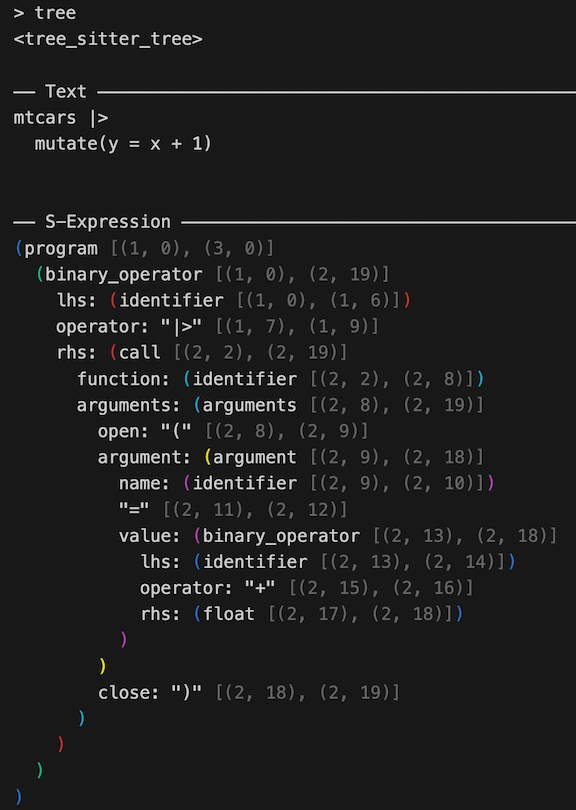The hardware and bandwidth for this mirror is donated by dogado GmbH, the Webhosting and Full Service-Cloud Provider. Check out our Wordpress Tutorial.
If you wish to report a bug, or if you are interested in having us mirror your free-software or open-source project, please feel free to contact us at mirror[@]dogado.de.
treesitter provides R bindings to tree-sitter, an incremental parsing system. It can build a concrete syntax tree for a source file and efficiently update the syntax tree as the source file is edited. tree-sitter is useful for a number of things, including syntax highlighting, go-to definition, code reshaping, and more.
Install treesitter from CRAN with:
install.packages("treesitter")This package does not provide bindings to a language specific tree-sitter grammar. To fully utilize the treesitter package, you will also need to install a grammar specific R package. Currently there is just one, for R:
install.packages("treesitter.r")You can install the development version of treesitter from GitHub with:
# install.packages("pak")
pak::pak("DavisVaughan/r-tree-sitter")With treesitter, you can parse a string containing code for any language that you have a grammar for. Here’s an example with R code:
library(treesitter, warn.conflicts = FALSE)
# Language specific grammars come from extension packages
language <- treesitter.r::language()
parser <- parser(language)
# Imagine this is a source document
text <- "
1 + 2
"
# Parse the text and display the resulting syntax tree
parser_parse(parser, text)
#> <tree_sitter_tree>
#>
#> ── Text ────────────────────────────────────────────────────────────────────────
#>
#> 1 + 2
#>
#>
#> ── S-Expression ────────────────────────────────────────────────────────────────
#> (program [(0, 0), (2, 0)]
#> (binary_operator [(1, 0), (1, 5)]
#> lhs: (float [(1, 0), (1, 1)])
#> operator: "+" [(1, 2), (1, 3)]
#> rhs: (float [(1, 4), (1, 5)])
#> )
#> )Syntax trees can get pretty complex, here’s a larger example:
text <- "
mtcars |>
mutate(y = x + 1)
"
tree <- parser_parse(parser, text)Trees and nodes have a pretty nice print method that colors matching
parentheses and dims the locations. If you were to print out
tree in your R console, here’s what you’d see:

treesitter has a number of tools for navigating around and walking the tree:
# The right hand side of the pipe
node <- tree |>
tree_root_node() |>
node_child(1) |>
node_child_by_field_name("rhs")
node_text(node)
#> [1] "mutate(y = x + 1)"By default, printing a node in the tree will show both the
anonymous nodes and the named nodes. Anonymous nodes
help you see the full “concrete” syntax tree that tree-sitter builds. If
you want to see something more akin to an abstract syntax tree, you can
use node_show_s_expression(), which has a number of options
for customizing the tree view:
# Full detail
node_show_s_expression(node)
#> (call [(2, 2), (2, 19)]
#> function: (identifier [(2, 2), (2, 8)])
#> arguments: (arguments [(2, 8), (2, 19)]
#> open: "(" [(2, 8), (2, 9)]
#> argument: (argument [(2, 9), (2, 18)]
#> name: (identifier [(2, 9), (2, 10)])
#> "=" [(2, 11), (2, 12)]
#> value: (binary_operator [(2, 13), (2, 18)]
#> lhs: (identifier [(2, 13), (2, 14)])
#> operator: "+" [(2, 15), (2, 16)]
#> rhs: (float [(2, 17), (2, 18)])
#> )
#> )
#> close: ")" [(2, 18), (2, 19)]
#> )
#> )
# Compact view, more like an AST
node_show_s_expression(
node,
show_anonymous = FALSE,
show_locations = FALSE,
dangling_parenthesis = FALSE
)
#> (call
#> function: (identifier)
#> arguments: (arguments
#> argument: (argument
#> name: (identifier)
#> value: (binary_operator
#> lhs: (identifier)
#> rhs: (float)))))These binaries (installable software) and packages are in development.
They may not be fully stable and should be used with caution. We make no claims about them.
Health stats visible at Monitor.